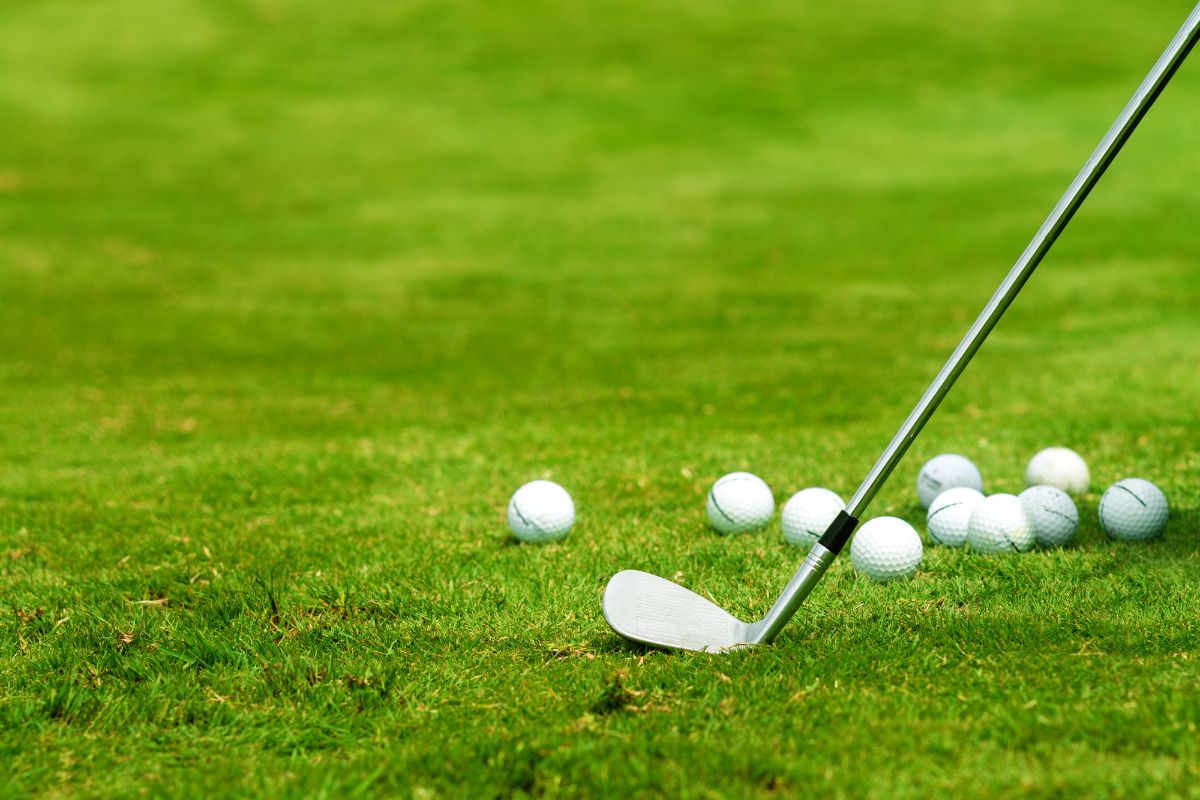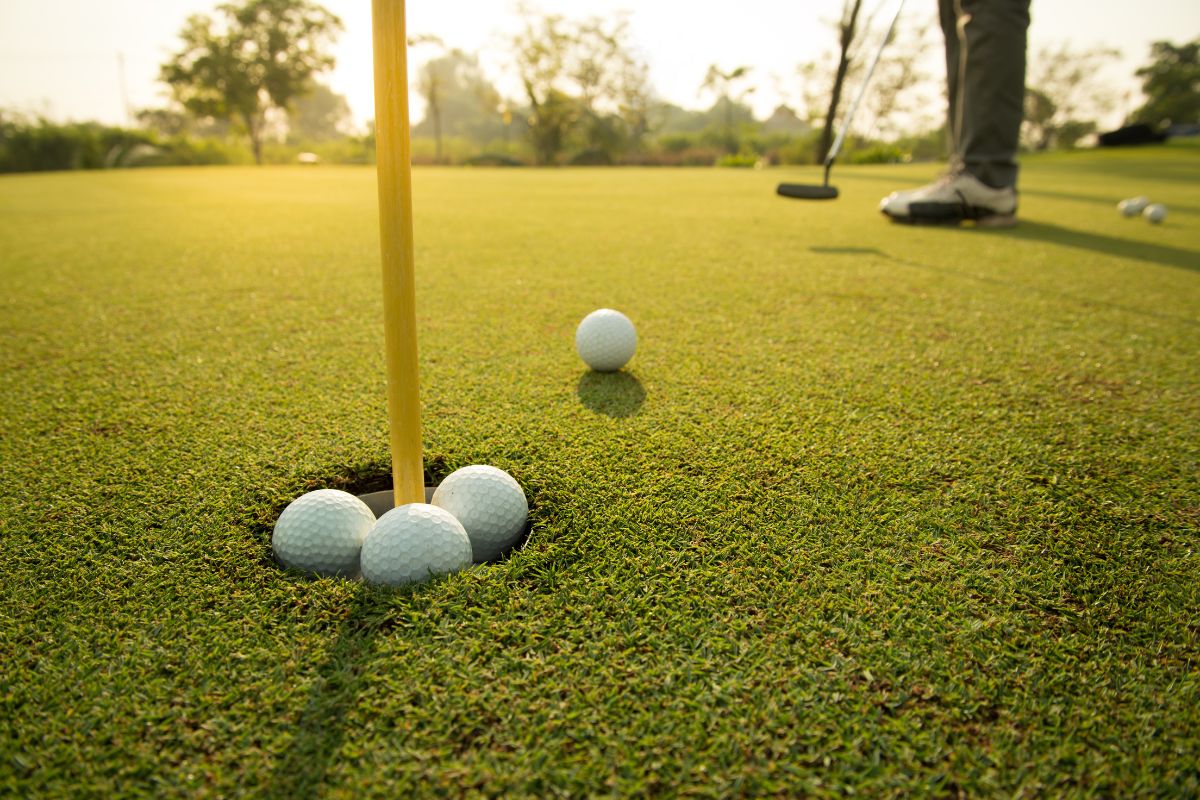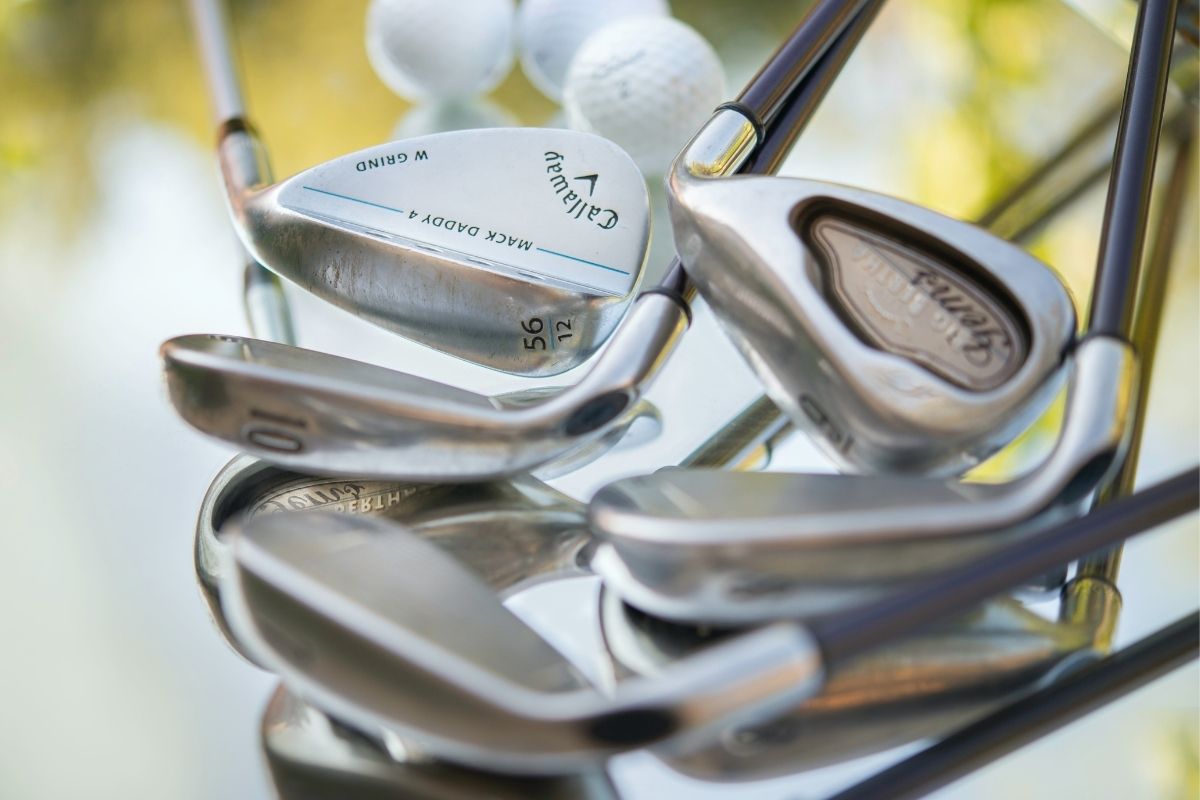We occasionally recommend products we love and might be paid a share of the sale.
As many golfers will tell you, you’re only as good as your clubs and you need to make sure that you’re prepared for every different scenario that comes your way.
We all know how frustrating it can be to have your ball in a position where you need a specific club to get out of the sticky situation. However, if you don’t have it, you’re going to struggle to play the shot properly.
There are lots of different clubs that you can have in your arsenal! Many will think of drivers, putters, and sand wedges as some of the most well-known, however, the reality is that there are a lot more out there to help you complete a golf course in as few strokes as possible.
The 60-degree wedge (or lob wedge) can be used in a few different scenarios and we’re here to help you highlight them.
Follow the rest of our guide to find out what a 60-degree wedge is, how to use one of these clubs, and when the best time is to use it. At the end of the day, it’s all well and good having these clubs at your disposal, but you need to know how and when to use them properly.

What Is A 60-Degree Wedge?
Of course, we all guessed by now that a 60-degree wedge is a type of golf club that you’re bound to find in a lot of different golfers’ sets. But, what does it do?
We all know that you can’t use any club for any old situation. For example, if you need to hit your ball long, straight, and fast, then a driver is definitely the best choice, rather than something like a pitching wedge or a gap wedge.
If you picture that at a 45-degree angle, you’re bound to see the ball traveling at a trajectory of a fairly medium gradient. So think, a 60-degree angle is going to be a little bit higher than that. 15-degrees higher to be exact!
That means that this wedge can hit the ball reasonably high, with a shorter landing distance than something like a 7-iron or a 9-iron.
When Do I Use A 60-Degree Wedge?
So, now we have a basic understanding of what a 60-degree wedge is, we can move on to when you’re going to use it and when you’re going to be needing it.
We all know that there are certain clubs that are needed for specific situations. Although it sounds like you might not need it because of how many situations can occur in golf, you’d be surprised how often these bad boys are needed on the golf course.
You’re likely to need this golf club when you need to hit the ball over a specific object or area. For example, if you’re within sight of where you need to be, but you have a water hazard of a sand bunker in your way, then you should look for your 60-degree wedge in your golf bag.
Pull it out and hit the ball over one of these hazards and try to leave it where you need to be for your next shot. It definitely comes in handy every so often!
A lot of the dependency on the 60-degree wedge comes down to the type of golf course you plan to be playing on. If you’re going to be taking part in a game on a fairly easy and basic course, then you might not always need one of these clubs.
However, if you have a golf course with lots of hazards and obstacles, then you might need one of these clubs often.
These clubs are quite versatile and can be used in a whole variety of different situations. We recommend considering this golf club when on the fairway, in the rough, in the sand, on a good lie, or on a bad lie.
As we mentioned, you should definitely use this club when you need to lob the ball over an area or obstacle.
Should I Use This Club Eve Time I Need To Chip The Ball, Or Should I Vary My Clubs?
From our own experience, we’ve found that there are basically two different routes that you can take when it comes to either varying your clubs or not. There are two different ways of going about things and we’ll look at them now.
Option 1: Use The 60-Degree Wedge For Every Chip Shot
A lot of people find that the best way of getting the most out of these clubs is to ensure that you use them in as many situations as you can.
Of course, we don’t mean to start using this wedge instead of a driver or a putter, but we want you to understand that a lot of chip shots can be suitable for a 60-degree wedge.
The best way to get comfortable with a certain type of club is to use it whenever you can in varying situations.
This is how you can get used to the weight of the club, the range of the club, and the way it reacts to the ground and different lies throughout a golf course. This is definitely easier than using it every so often and not getting consistent use out of your club.
Basically, it takes all of the guesswork out of your game and makes sure that your club starts to feel like an extension of your arms, rather than a piece of equipment that you haven’t used for a while.
Pro golfers have a lot more time to practice than the majority of us who play for fun or at an amateur level, meaning we have to make the most of the time we have on the links!
The three best shots to use when the 60-degree wedge is present are:
- Standard chip shots involving little hinge set, making sure to utilize the bounce from the club.
- The flop shot where the ball is played a bit forward, using the club’s natural hinge.
- The hinge and hold technique when you’re trying to aim for a lower shot. However, this method can be quite difficult.
If it’s not a bump and run when you get to the ball, then the question you have to be asking yourself is what shot is best for the situation at hand. If you’ve short-sided yourself, then the flop shot could be the way to go.
A simple shot that can be hit off almost any lie on the course is also a good choice. Sometimes, simpler is better! This is an easy motion where the club skims across the ground, staying calm and collected in the process.
Option 2: Vary Your Clubs, Rather Than Just The 60-Degree Wedge
If the last choice doesn’t appeal to you, then a lot of golfers like to vary their choices up every so often. There’s no shame in it! You have a wide set of clubs for a reason.
There are other similar clubs like a 56-degree wedge or a 54-degree wedge, which can also do a similar job to a 60-degree wedge. These can offer something slightly lower for you!
If you want to improve your technique over a range of clubs, then using different wedges might be the best direction for you to travel in.
If you have a general motion that you like to use, then using different clubs can be a great way for you to improve your selections and decision-making with different scenarios and with finding the right club to use.
If you’re wondering what kinds of clubs and wedges are used for chipping the ball, then it’s fairly simple.
Usually, anything from a 7-iron down to a 60-degree wedge can be used for chipping the ball and can help you in a whole range of different situations and scenarios. You just have to choose the right one depending on what trajectory you want to use.
How Do I Choose Which Option?
We’ve explained the two options to you, now it’s down to you to make a choice. Don’t worry, though! We’re here to help you find out which one is the best for you and the way you play. After all, practice makes perfect and we know that you can find the best option with some time and effort.
Step 1 – Practice Your Shots

As we said, practice makes perfect! We understand that there are lots of different shots and scenarios to choose from, so you have two choices!
You can either hit the golf course with some friends and try the clubs straight away, or you can play it a bit safer.
Why not head to a driving range with a 60-degree wedge and try out some shots of varying distances and ranges? Just choose a target and aim to hit it, or get as close to it as possible!
Step 2 – Use Your 60-Degree Wedge With 10 Shots For Practice
If you want to get straight onto a quiet golf course, then you should try a range of different shots and try to chip the ball over an object or distance, aiming for the green or a specific area.
Only use your 60-degree wedge and note down the results and findings for later use. We’ll continue this step in step 4.
Step 3 – Vary Your Clubs With 10 Shots For Practice
Now, go with the other option we suggested earlier and follow the same 10 shots but with varying clubs this time. Use anything like a 7-iron, a 9-iron, a 54-degree wedge, or a 56-degree wedge.
Do the same, aim over an obstacle or aim for a certain area, target, or location. Once again, note down the results and then move on to our next step.
Step 4 – Repeat The Last Two Steps Twice More
Consistency is key when it comes to collecting data. It’s the same in any field, the more data you have, the more likely you are to get an accurate idea of what’s going on.
By having more shots, you give yourself more data to collect and work off of. Once you have about 30 shots of each, you can compare the data, which we’ll talk about in the next step.
Step 5 – Comparing The Data And Analyzing
From here, you can now compare the data of the two lots of 30 shots, and see which one has the better results. If you find that you were better with a variety of clubs, then you can either focus on improving with the 60-degree wedge, or you can stick to what you think is best.
From here, you can choose which area of your game to focus on. However, you can also find you’re better with the 60-degree wedge and focus on making that area even better.
Additional Note
You don’t have to do all of this in one day. If you want to practice with different weathers and courses, you can do this over separate days and compare even more results.
It’s like we said, the more data you have, the more you have to analyze and compare. If you can record over 100 or 200 shots, you will have a great idea of what you need to do.
By aiming for a higher number of shots and a larger range of data, you’re also spending a lot of time and effort on practicing with chip shots and a 60-degree wedge, or similar clubs.
At the end of the day, someone who spends a lot of time on the golf course practicing is always going to get a lot better in the long run.
How Far Can A 60-Degree Wedge Hit A Ball?
We all know that the harder and faster you swing, the further you can hit a ball. However, there are a lot of clubs that are better suited for range, rather than height.
Everyone has their comfort zone and will feel a lot better hitting a golf ball and we find that ours tends to be in the range between 60 and 80 yards of distance. However, longer hitters may be hit the lob wedge 100 yards or more!
Of course, not every shot is going to land between the 60 and 80-yard range, but that’s the general aim when we use a 60-degree wedge.
Related article: Average Golf Club Distances Every Golfer Wants To Know To Play Better
We always recommend that you don’t take a full swing with chip shots so you can maintain some sort of control over your swing and the power behind the ball. When you give 100% of a swing behind the ball, you risk hitting it too hard and losing control.
It’s always good to keep in mind that chipping the ball and using wedges is all about precision and trying to hit a specific target.
Alternatively, it is about trying to avoid a target like a sand bunker or a water hazard, so you should always be cautious and prepare your shot accordingly. Staying smooth with your swing and keeping things calm is always the best way to go.
Additional Tip
If you need to take a bigger swing when using your 60-degree wedge, we always recommend that you keep the ball down the center to the back of your stance.
Make sure you have some weight kept pre-loaded on the front side. If you forget to keep this technique in mind, then you might find that the ball is traveling too high, without the distance you need.
If you execute the shot properly, you should have relative control over which degree of the direction the ball will be taking.
Professional golfers tend to de-loft their wedges and clubs a lot of the time to help control the launch angle, the overall distance of the shot, and the spin rate of the ball. Reducing the loft and making sure you hit the ball before you hit the ground will put a spin on the ball, should you want to use it.
How To Use A 60-Degree Wedge
Firstly, we recommend that you learn how to use the bounce on the club. The vast majority of wedges are built with a good amount of bounce to help prevent the club from digging into the ground before striking the ball.
Nobody wants to flub the ball 2 yards in front of their friends!
Place the club on the ground and make a consistent back and through swing, which will help you to prevent from digging or lifting up on the golf ball. The club should slide through and chip the ball toward the hole.
Conclusion
There you have it! All you need to do is take some time to practice and make sure that you’ve got the technique and the weight of the club known off by heart. At the end of the day, the more you practice your shots and your technique, the better you’re going to be able to place your shots.
The 60-degree wedge is a very useful club to have in your golf bag and we recommend making sure that you kept it in mind when you need to get the ball up and over an obstacle and stop fast on the green.
- Funny Golf Terms - February 21, 2023
- How To Play Vegas Golf Game - February 16, 2023
- How To Play Wolf Golf Game - February 16, 2023








